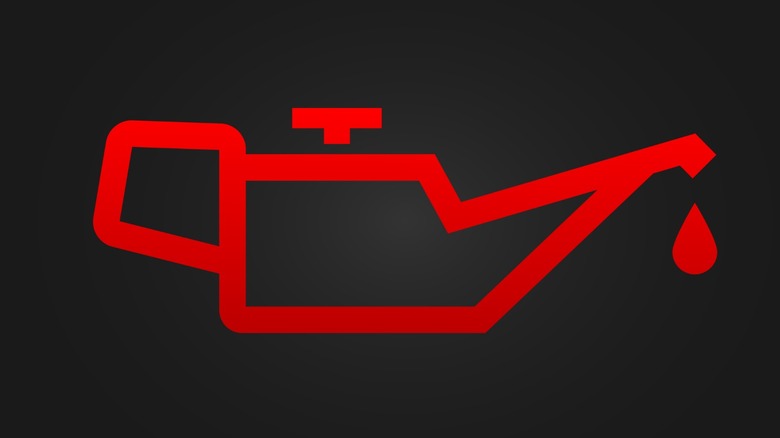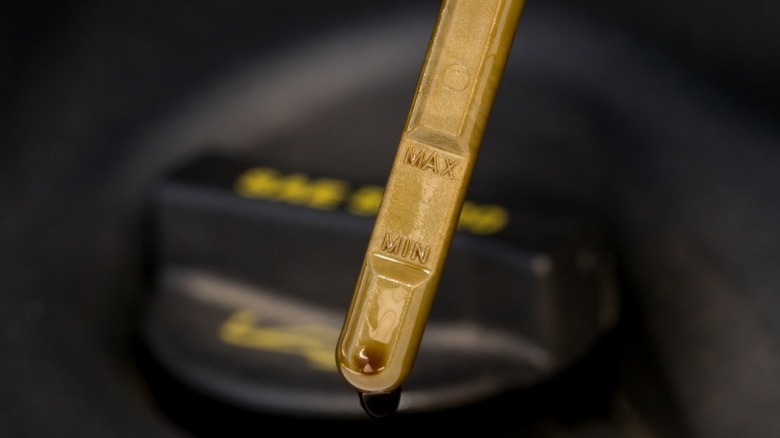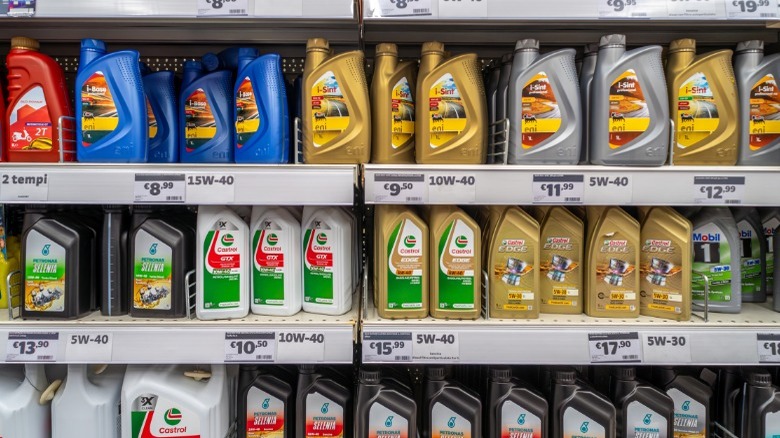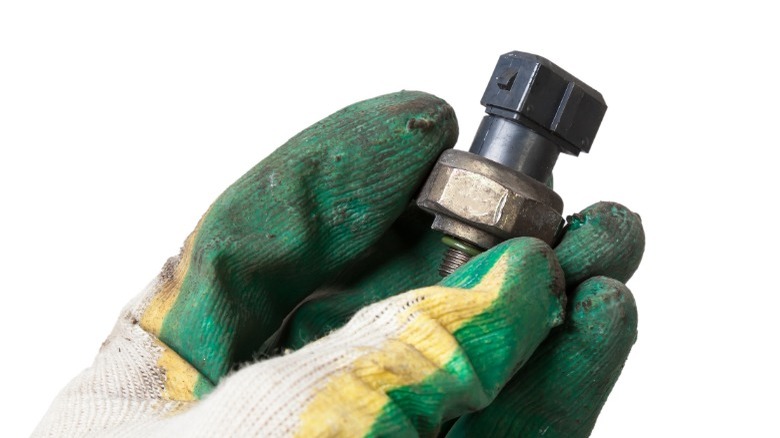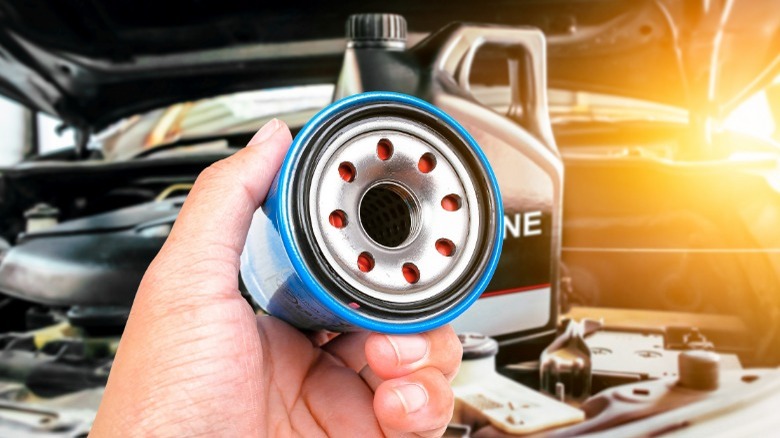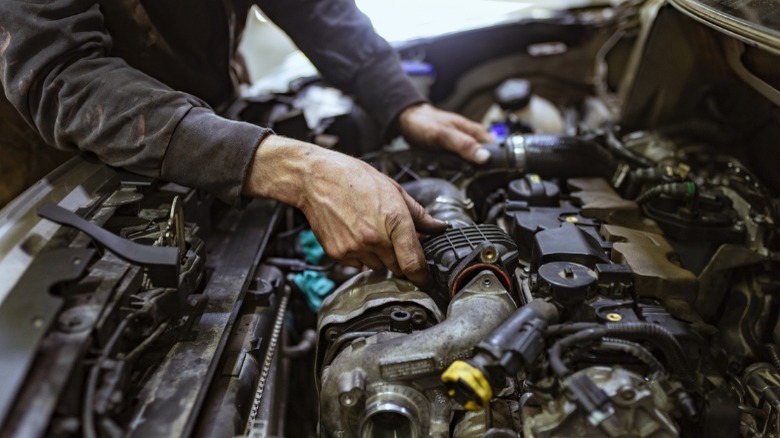5 Causes Of Low Engine Oil Pressure (And Fixes To Try)
Most people understand that motor oil is a vital component for the internal combustion engines that power most of our cars. Not only does oil act as a lubricant, allowing internal moving parts to slide past one another without jamming up or causing damage, but it also functions as a heat sink, absorbing excess heat generated by the engine and carrying it away from sensitive components. Motor oil is able to accomplish these feats thanks to a combination of two critical factors: viscosity and pressure.
Viscosity refers to the oil's thickness, which contributes to the oil's ability to provide sufficient lubrication. Oil pressure, on the other hand, can be thought of as a measure of how much force is moving the fluid through your engine. If the pressure is too low, oil won't be able to reach all moving parts to provide sufficient lubrication. If the pressure is too high, excess heat may develop. Both scenarios can cause extensive and expensive damage to your vehicle's engine.
Most cars are built with a sensor that tracks the oil pressure inside your motor. The sensor then relays that data to the computer, which displays the information via a gauge on your dashboard. If your gauge drops suddenly, it could mean your car's oil pressure is dangerously low. But what exactly causes low engine oil pressure? The answer is that various issues can cause this problem. Fortunately, we'll break it down for you. As a former automotive repair technician, I'll explain the most common causes of low oil pressure in simple terms, so that you can recognize the problem and take the proper steps to address it. So, from low oil to excessive engine wear, here are five causes of low engine oil pressure and a few fixes.
Check for low oil levels
One of the primary causes of low oil pressure is a low oil level. It's pretty straightforward — if your car's engine doesn't have the right amount of oil, it follows that it will be unable to maintain the proper oil pressure. We've already mentioned that oil is absolutely essential for your vehicle's motor. If the level is too low, not only will your engine oil pressure drop, potentially causing various problems, but you may also experience issues ranging from an overheating engine to a completely seized motor. Those are serious problems, and they can be extremely costly to repair, which is why it's crucial that you monitor your engine oil level regularly to ensure that it remains within the acceptable zone.
Fortunately, it's pretty easy to fix a low oil level. Your oil level may drop due to various issues, including excess consumption and engine oil leaks, and many of these problems can be challenging and expensive to repair. However, adding extra oil to your motor is quick and simple. All you need to do is pop your car's hood and pull the dipstick to check the level. If it's too low, add small amounts until the level is within the acceptable range. Remember, do not dump a complete bottle of oil into your engine all at once, unless you've just drained the motor as part of an oil change.
Incorrect oil type was added to the engine
We mentioned that oil viscosity plays a vital role in your car's engine. It's also worth mentioning that different engines require oils with different viscosities. Those numbers that you can find on your motor's oil fill cap refer to the type and classification of oil the engine needs. While many engines are capable of running a couple of different oil viscosities — for example, some Toyota RAV4s accept both 0W-20 and 5W-20 oil — straying too far from the accepted range can have disastrous consequences. One of those consequences is a drop in engine oil pressure, and it can lead to various other problems, including difficulty starting your car, overheating, and broken internal parts.
It's crucial that you follow your manufacturer's instructions when it comes to the type of oil your car needs. As mentioned, your engine's oil fill cap should show the required oil type, but you can also find that information by checking your vehicle owner's manual, reaching out to the dealership, or visiting an auto parts store and asking an employee to look the information up in their system.
If you do accidentally fill your engine with the incorrect type of oil, don't worry. Fortunately, it's a relatively easy problem to fix, but you need to act quickly and have the oil drained and refilled with the correct type of oil.
Oil pressure sensor or oil pump have failed
Oil level and type aren't the only things that can contribute to a drop in engine oil pressure. We already mentioned that your car relies on a sensor to monitor the oil pressure inside your engine. It also uses an oil pump to pressurize the oil and send it through the motor. If either of these components fails or becomes damaged, the motor may be unable to maintain the proper oil pressure. That said, it may be difficult to confirm that the pump or sensor is faulty without professional help. If you notice a drop in your oil pressure, and you're confident that your engine is filled to the proper level with the correct type of oil, you should contact a professional mechanic for an inspection.
Unfortunately, fixing issues caused by a worn-out oil pressure sensor or oil pump almost always involves replacing the parts, which can be substantially more complex and expensive than many of the other fixes on this list. Of the two components, the oil pressure sensor is the simplest and most affordable to replace. If you visit a professional repair shop for the sensor replacement, you'll likely pay around $150. An oil pump replacement, on the other hand, is a much more involved repair job. If you hire a professional mechanic to replace the pump for you, you should expect to pay at least $1,000.
Check the oil filter to see if it is clogged
One of the most important parts of your car's engine lubrication system is the oil filter. That's because even if you consistently change the oil in your car, it's going to accumulate debris and impurities over time. The filter's job is to prevent those contaminants from making their way back into the engine and causing damage to sensitive components. However, the filter isn't impervious to damage, and if you don't replace it regularly, it can become clogged. When that happens, oil won't be able to flow freely through the system, resulting in a potential drop in engine oil pressure and various other problems.
Ideally, you should be replacing your engine oil filter each time you change the oil. For most cars, that means performing the service every 3,000 to 7,500 miles. If you don't replace your oil filter, and it becomes clogged, the fix is pretty self-explanatory: remove the old filter and replace it with a new one. You can do this yourself if you want to save a few bucks, or you can visit an auto repair shop for a complete oil change. Either way, it's not a super expensive fix. An oil filter alone shouldn't cost more than $5 to $20, and if you pay a mechanic for a complete oil change, it will most likely cost you between $50 and $100.
Excessive engine wear
Another common cause of low oil pressure is excessive engine wear. This issue affects older vehicles predominantly, and it's usually caused by the wear and tear that accompanies old age in car engines. The problem occurs because as an engine runs, internal parts wear down. Even when you maintain your vehicle properly, some friction and wear is unavoidable. Over time, that wear can widen the passages through which the oil flows and wear down components like the piston bearings, resulting in engine oil pressure drops.
Unfortunately, engine wear is a fact of life, no matter how well you treat your car. Once a motor reaches a certain level of wear, there's not a lot that you can do to fix it without performing a complete rebuild or replacement. The good news is that you can increase your engine's life dramatically by following your manufacturer's instructions and a set maintenance schedule. That means keeping up with routine services like oil changes, air filter replacements, and coolant flushes, as well as remembering to perform maintenance with longer intervals like tune-ups, belt replacements, and timing adjustments.
Treating your engine with care can go a long way toward extending its life, and that doesn't just mean following your manufacturer's maintenance instructions. If you really want to protect your motor, you should also avoid hot rodding your car around town, filling the engine with impure fuel, and installing cheap aftermarket modifications. Nothing is guaranteed, but following the above steps will drastically increase your engine's chances of a long, healthy life.
